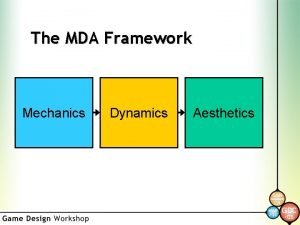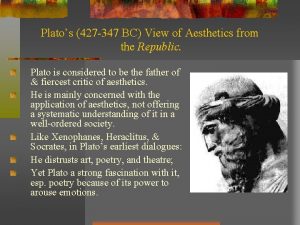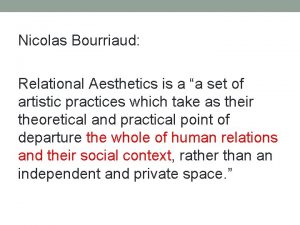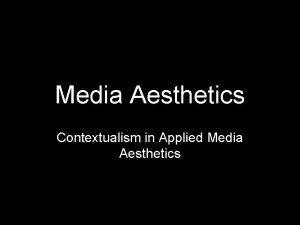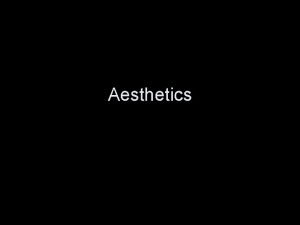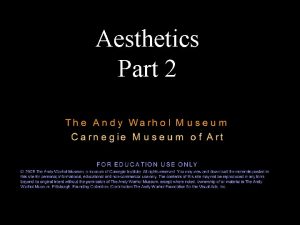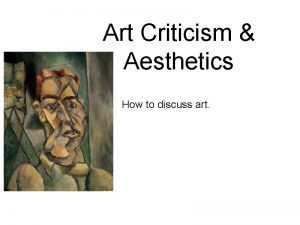INTRODUCTION Week 2 Art History and Aesthetics Why















- Slides: 15

INTRODUCTION: Week 2 Art History and Aesthetics… Why should I care? Critical reflection on art, culture and nature.

What is aesthetics? • is a branch of philosophy dealing with the nature of beauty, art, and taste, and with the creation and appreciation of beauty (or ugliness). • Well then, what is BEAUTY? ? ?

Beauty is… • Beauty is a characteristic of a person, animal, place, object, or idea that provides a perceptual experience of pleasure, meaning, or satisfaction. • Everyone has a different perception of what beauty is… What is an example of an experience of satisfaction through something off-putting? Would that make it beautiful instead?

Aesthetic Judgment • Immanuel Kant in 1790 wrote "If (a man) says that wine is agreeable he is quite content if someone else corrects his terms and reminds him to say instead: It is agreeable to me, " because "Everyone has his own (sense of) taste". • Judgments of beauty are sensory, emotional and intellectual all at once.

How does this apply to art? • Aesthetic judgments are strongly influenced by time and culture.

What is art? • the products of human creativity • the creation of beautiful or significant things • a superior skill that you can learn by study, practice and observation • the process or product of deliberately arranging elements in a way to affect the senses or emotions

Mark Rothko, No. 3/No. 13 (Magenta, Black and Green on Organge) 1949. Oil on Canvas Martha Knowles and Henrietta Thomas, My Sweet Sister Emma, 1843. Cotton quilt

Why is art important? • Art can act as a means to some special kind of knowledge. • Art may give insight into the human condition. • Art serves as a tool of education, indoctrination, or enculturation. • Working on the intended value of art helps define the relationship between art and other acts. For example, medicine is a science and an art.

What is Art History? • Works of art are seen as embodiments of the values, goals, and aspirations of its time and place of origin. • Art historians seek to understand the meaning of art from the past within its original cultural contexts, both from the point of view of its producers as well as from the point of view of its consumers.

The Three Types of Investigation • 1. Descriptive Analysis of subject matter and formal structure • 2. Interpretation of meaning and understanding the content intended by the artist. • 3. Judgement of the quality and success of the artist to produce a work that stimulates the intellect or fires the emotions.

Descriptive Analysis • Physical properties include shape, size, materials, and technique. • Most of this assessment is objective; what we see, what is “real and observable, " a piece of art in relation to a space or place, etc. • To fully understand technique, date of creation, artists, etc scientific methods or documentary research may be needed.

Descriptive Analysis • Formal Analysis: an established method for analyzing works of art – Assess the visual elements/formal vocabulary that constitute the pictorial or sculptural communication – Discover the overall arrangement, organization or structure of an image (the composition. )

Interpretation • First we perceive “natural subject matter, ” we recognize forms, objects and situations that are familiar to us from our own experience. • Then we use iconography to identify cultural, symbolic and conventional meanings specific to a particular time and place.

Judgment • Iconology – interpreting works of art as an embodiment of their cultural situation, to place them within broad social, political, religious and intellectual contexts. • This requires a deep understanding of the beliefs/values of the culture/time-period from which a piece of art came.

Week 2 Vocabulary • • • Formal Analysis Composition Modeling Foreshortening Axis Iconography Iconology Still Life Dendrochronology Cultural Context
 What is hegelian philosophy
What is hegelian philosophy Hey bye bye
Hey bye bye Introduction to aesthetics
Introduction to aesthetics Week by week plans for documenting children's development
Week by week plans for documenting children's development Beast and beauty aesthetics
Beast and beauty aesthetics Art emerging in europe
Art emerging in europe Dont ask why why why
Dont ask why why why Gestalt aesthetics
Gestalt aesthetics Racquel aesthetics
Racquel aesthetics Aesthetics elements
Aesthetics elements The concept of aesthetics
The concept of aesthetics Mechanics dynamics aesthetics examples
Mechanics dynamics aesthetics examples The aesthetics studio
The aesthetics studio Platos aesthetics
Platos aesthetics Nicolas bourriaud relational aesthetics
Nicolas bourriaud relational aesthetics Transcendental aesthetic kant
Transcendental aesthetic kant











